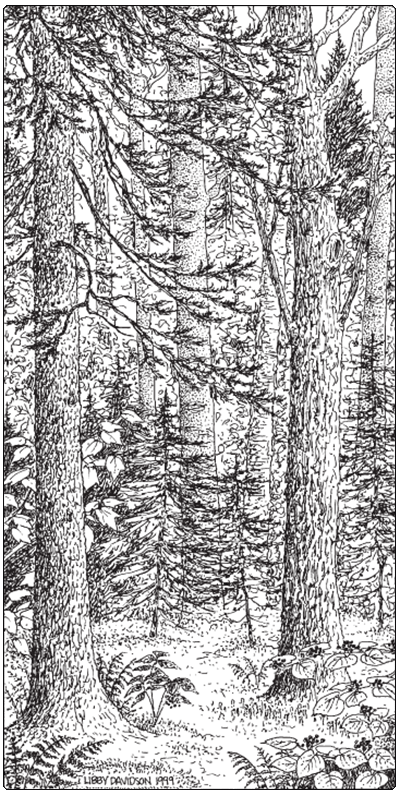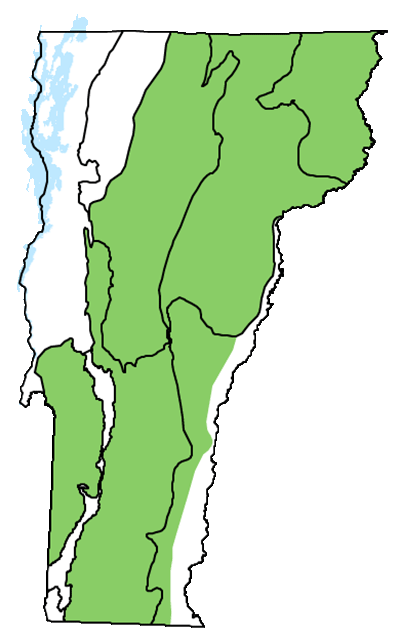Ecology and Physical Setting
The tall, columnar trunks of red spruce are a striking contrast to the spreading branches of northern hardwoods in this variable and enchanting community. The crisp, green spruce spires stand out against the hardwoods, which have orange and red foliage in fall, and bare, gray branches in stick season.
Red Spruce-Northern Hardwood Forest occurs in cool-climate settings where boreal species begin to mix with northern hardwoods. Common situations where this occurs are on low flats or basins where cold air collects, and on mid-elevation mountain slopes. This community is often transitional between Northern Hardwood Forest and either Lowland Spruce-Fir Forest or Montane Yellow Birch-Red Spruce Forest in these settings. Soils range from well-drained to somewhat moist, depending on the topographic position. Parent materials are tills. In some cases, soils have a restricting layer, or hardpan, at 18-24 inches below the surface, making these areas particularly moist.
Red Spruce-Northern Hardwood Forest is one of Vermont’s matrix forests, covering many acres of the state’s cooler regions. Wind, ice, and insects are the primary causes of natural disturbance.
Vegetation
The canopy in these forests is a mix of red spruce, yellow birch, beech, and sugar maple in varying proportions. White ash is present in richer sites. Balsam fir and red maple may be common in some stands. The shrub layer is sometimes well developed, with hobblebush a common component. The herb layer comprises typical boreal herbs such as bluebead lily and shining clubmoss.
Wildlife Habitat
This cool-climate, mixed forest of spruce, birch, and beech supports hermit thrush, Blackburnian warbler, Canada warbler, blue-headed vireo, and broad-winged hawk. Black-throated blue warblers nest in dense hobblebush thickets, which are common in Red Spruce-Northern Hardwood Forests. Barred owls prefer tree cavities for nesting; these cavities are more common in mature forests. Northern goshawks are found in large unfragmented forests. Beech is common in these forests and beech nuts are an important food for black bears, turkeys, blue jays, and many other species.
Successional Trends
In many forests of this type, red spruce, hemlock, and yellow birch may become dominant over time, depending on the physical setting.
Historical data indicates that red spruce was once much more abundant in many of Vermont’s forests, but has declined because of selective logging in the past as well as more recent impacts from atmospheric pollution (Cogbill et al. 2002). Research suggests that red spruce in the northern Green Mountains is expanding its range downslope, so many Red Spruce-Northern Hardwood Forests may be in the process of recovering from these past disturbances (Foster and D’Amato 2015).
What first appears to be a Red Spruce-Northern Hardwood Forest may, in some cases, be a successional stage of what will ultimately become softwood forest. Early to mid-successional species include balsam fir, paper birch, white pine, red maple, aspen, pin cherry, and gray birch.
Related Communities
- Montane Yellow Birch-Red Spruce Forest In their extreme expressions, these two communities are quite different and easily distinguishable, but there is some overlap between them as well. In general, Montane Yellow Birch-Red Spruce Forest has less tree diversity, except at lower elevations where sugar maple and beech mix in.
- Northern Hardwood Forest is closely related to Red Spruce-Northern Hardwood Forest and often occurs adjacent to it. Northern Hardwood Forest can have a minor component of red spruce in its canopy, but it generally lacks the dominance of boreal herbs.
- Lowland Spruce-Fir Forest can be similar to Red Spruce-Northern Hardwood Forest, but it has only a minor component of hardwood species.
- Montane Spruce-Fir Forest can be similar to Red Spruce-Northern Hardwood Forest, but it has only a minor component of hardwood species, is colder, and has higher rainfall.
Conservation Status and Management Considerations
This is a common community in Vermont, and good examples can be found on state and federal conserved lands. Where this community is managed, foresters should consider successional tendencies, favoring species that would naturally occur on the site in question.
Distribution/Abundance
Since much of Vermont is in an area of transition between northern hardwood forests and spruce-fir forests, this community is common here.
It reaches its best expression in Vermont on the plateau of the Southern Green Mountains. Similar communities are found throughout New England.
Characteristic Plants
Trees
Abundant Species
Red spruce – Picea rubens
Yellow birch – Betula alleghaniensis
American beech – Fagus grandifolia
Occasional to Locally Abundant Species
Sugar maple – Acer saccharum
Eastern hemlock – Tsuga canadensis
Balsam fir – Abies balsamea
Red maple – Acer rubrum
Early-successional Species
Paper birch – Betula papyrifera
Pin cherry – Prunus pensylvanica
Quaking aspen – Populus tremuloides
Shrubs
Abundant Species

sight in Red Spruce-Northern Hardwood Forest.
Hobblebush – Viburnum lantanoides
Striped maple – Acer pensylvanicum
Mountain maple – Acer spicatum
American mountain ash – Sorbus americana
Herbs
Common wood sorrel – Oxalis montana
Bluebead lily – Clintonia borealis
Painted trillium – Trillium undulatum
Starflower – Lysimachia borealis
Canada mayflower – Maianthemum canadense
Sarsaparilla – Aralia nudicaulis
Twinflower – Linnaea borealis
Intermediate wood fern – Dryopteris intermedia
Bladder sedge – Carex intumescens
Drooping woodreed – Cinna latifolia
Whorled aster – Oclemena acuminata
Wood millet – Milium effusum
Shining clubmoss – Huperzia lucidula
Associated Animals
Fisher – Pekania pennanti
Snowshoe hare – Lepus americanus
Northern flying squirrel – Glaucomys sabrinus
Gray fox – Urocyon cinereoargenteus
Moose – Alces americanus
Black bear – Ursus americanus
Hermit thrush – Catharus guttatus
Canada warbler – Cardellina canadensis
Blackburnian warbler – Setophaga fusca
Black-throated green warbler – Setophaga virens
Black-throated blue warbler – Setophaga caerulescens
Olive-sided flycatcher – Contopus cooperi
Blue-headed vireo – Vireo solitarius
Winter wren – Troglodytes hiemalis
Ruffed grouse – Bonasa umbellus
American woodcock – Scolopax minor
Broad-winged hawk – Buteo platypterus
Barred owl – Strix varia
Rare and Uncommon Animals
Long-tailed shrew – Sorex dispar
Northern goshawk – Accipiter gentilis
Places to Visit
Victory State Forest, Victory, Vermont Department of Forests, Parks, and Recreation (VDFPR)
Okemo State Forest, Ludlow and Mount Holly, VDFPR
